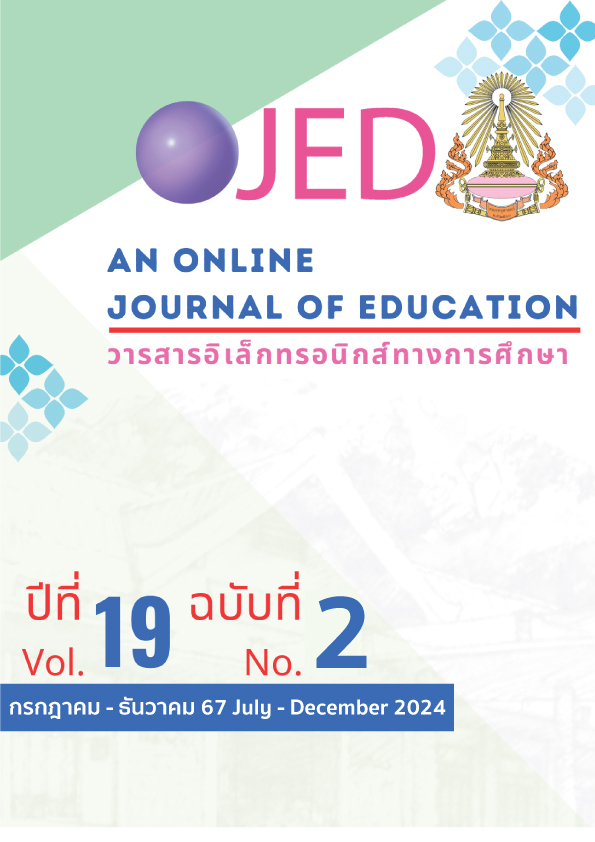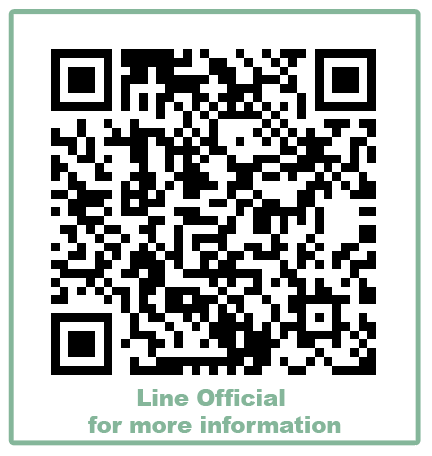ผลการจัดกิจกรรมการเรียนรู้คณิตศาสตร์โดยใช้โมเดล MEAs ที่มีต่อความสามารถในการคิดวิเคราะห์ของนักเรียนระดับมัธยมศึกษาตอนต้น
DOI:
https://doi.org/10.14456/ojed.2024.3คำสำคัญ:
โมเดล MEAs, ความสามารถในการคิดวิเคราะห์, การเรียนรู้ที่เน้นปัญหาเป็นฐาน, การล้วงความคิด, ตัวแทนความคิดทางคณิตศาสตร์บทคัดย่อ
การวิจัยนี้มีวัตถุประสงค์เพื่อ 1) เปรียบเทียบความสามารถในการคิดวิเคราะห์ของนักเรียนที่ได้รับการจัดกิจกรรมการเรียนรู้คณิตศาสตร์โดยใช้โมเดล MEAs ระหว่างก่อนเรียนและหลังเรียน และ 2.) เปรียบเทียบความสามารถในการคิดวิเคราะห์ของนักเรียนที่ได้รับการจัดกิจกรรมการเรียนรู้คณิตศาสตร์โดยใช้โมเดล MEAs ระหว่างหลังเรียนกับเกณฑ์ร้อยละ 60 ของคะแนนเต็ม กลุ่มตัวอย่างได้มาจากการคัดเลือกแบบเจาะจง (purposive sampling) เป็นนักเรียนชั้นมัธยมศึกษาปีที่ 3 โรงเรียนขนาดใหญ่แห่งหนึ่งในจังหวัดเชียงราย จำนวน 33 คน เครื่องมือที่ใช้ในการวิจัย คือ แผนการจัดกิจกรรมการเรียนรู้คณิตศาสตร์ จำนวน 14 แผน และแบบวัดความสามารถในการคิดวิเคราะห์ฉบับก่อนเรียนและฉบับหลังเรียน วิเคราะห์ข้อมูลโดยใช้ค่าเฉลี่ยเลขคณิต ส่วนเบี่ยงเบนมาตรฐาน ร้อยละ และการทดสอบค่าที ผลการวิจัยพบว่า 1) นักเรียนมีความสามารถในการคิดวิเคราะห์หลังเรียนสูงกว่าก่อนเรียนอย่างมีนัยสำคัญทางสถิติที่ระดับ 0.5 ทั้งในภาพรวมและรายด้าน และ 2) นักเรียนมีความสามารถในการคิดวิเคราะห์หลังเรียนสูงกว่าเกณฑ์ร้อยละ 60 ของคะแนนเต็มอย่างมีนัยสำคัญทางสถิติที่ระดับ .05 ในภาพรวม รวมไปถึงรายด้าน ประกอบด้วย ด้านการจำแนก ด้านการพิจารณาความสัมพันธ์ และด้านการตรวจสอบ ส่วนด้านการลงข้อสรุปและด้านการนำไปใช้ นักเรียนมีความสามารถในการคิดวิเคราะห์ สูงกว่าเกณฑ์ร้อยละ 60 ของคะแนนเต็มอย่างไม่มีนัยสำคัญ
เอกสารอ้างอิง
ภาษาไทย
กระทรวงศึกษาธิการ. (2551). ตัวชี้วัดและสาระแกนกลางกลุ่มสาระการเรียนรู้คณิตศาสตร์ ตามหลักสูตรแกนกลางการศึกษาขั้นพื้นฐาน พุทธศักราช 2551. โรงพิมพ์ชุมนุมสหกรณ์การเกษตรแห่งประเทศไทย.
เกรียงศักดิ์ เจริญวงศ์ศักดิ์. (2546). การคิดเชิงวิเคราะห์. ซัสเซส มีเดีย.
ชาญชัย ยมดิษฐ์. (2548). เทคนิคและวิธีการสอนร่วมสมัย (พิมพ์ครั้งที่ 1 ). หลักพิมพ์.
ชาติ แจ่มนุช. (2545). สอนอย่างไรให้คิดเป็น. เลี่ยงเชียง.
ซูรายา สัสดีวงศ์. (2555). การพัฒนากระบวนการจัดการเรียนรู้โดยบูรณาการรูปแบบการพัฒนา ความคิดทางคณิตศาสตร์และแนวคิดการใช้ปัญหาเป็นหลักเพื่อส่งเสริมความสามารถในการคิด วิเคราะห์และความสามารถในการอก้ปัญหาทางคณิตศาสตร์ของนักเรียนชั้นมัธยมศึกษาทาง คณิตศาสตร์ของนักเรียนชั้นมัธยมศึกษาปีที่ 2 [วิทยานิพนธ์ปริญญามหาบัณฑิต]. จุฬาลงกรณ์มหาวิทยาลัย. Chulalongkorn University Intellectual Repository (CUIR). https://cuir.car.chula.ac.th/bitstream/123456789/45041/1/suraya_sa.pdf
ทิศนา แขมมณี และจุฬาลงกรณ์มหาวิทยาลัย ภาควิชาประถมศึกษา. (2544). วิทยาการด้านการคิด. เดอะมาสเตอร์กรุ๊ปแมเนจเม้นท์.
รัญชนา ทรงไชย และ จุไรรัตน์ อาจแก้ว. (2561). การเปรียบเทียบผลสัมฤทธิ์ทางการเรียนและความสามารถในการคิดวิเคราะห์ทางคณิตศาสตร์ของนักเรียนระดับชั้นประถมศึกษาปีที่ 5 ระหว่างรูปแบบการจัดการเรียนรู้โดยใช้ปัญหาเป็นฐาน(PBL) และการจัดการเรียนรู้ตามปกติ. วารสารมนุษยศาสตร์และสังคมศาสตร์ มหาวิทยาลัยพะเยา, 7(2), 24-41.
ลักขณา สริวัฒน์. (2549). การคิด. โอเดียนสโตร์.
ศูนย์ดำเนินงาน PISA แห่งชาติ สถาบันส่งเสริมการสอนวิทยาศาสตร์และเทคโนโลยี. (2564). ผลการประเมิน PISA 2018 การอ่าน คณิตศาสตร์ และวิทยาศาสตร์. สถาบันส่งเสริมการสอนวิทยาศาสตร์และเทคโนโลยี (สสวท.).
สุคนธ์ สินธพานนท์, วรรัตน์ วรรณเลิศลักษณ์, และ พรรณี สินธพานนท์. (2550). พัฒนาทักษะการคิดพิชิตการสอน. กรุงเทพฯ: จุฬาลงกรณ์มหาวิทยาลัย.
สิรินทรา มินทะขัติ. (2556). ผลของการจัดกิจกรรมการเรียนรู้โดยใช้ปัญหาเป็นฐาน (Problem-based learning) เรื่อง พื้นที่ผิวและปริมาตร ที่มีต่อความสามารถในการคิดวิเคราะห์ และความสามารถในการให้เหตุผลทางคณิตศาสตร์ของนักเรียนชั้นมัธยมศึกษาปีที่ 3 [วิทยานิพนธ์ปริญญามหาบัณฑิต]. มหาวิทยาลัยศรีนครินทรวิโรฒ. https://ir.swu.ac.th/jspui/handle/123456789/4275
สุวิทย์ มูลคํา. (2547). กลยุทธ์การสอนคิดประยุกต์. ภาพพิมพ์.
อัมพร ม้าคนอง. (2553). ทักษะและกระบวนการทางคณิตศาสตร์: การพัฒนาเพื่อพัฒนาการ. โรงพิมพ์แห่งจุฬาลงกรณ์มหาวิทยาลัย.
ภาษาอังกฤษ
Aziz, S. A., & Irwan, I. (2020). Validity Of Mathematical Learning Material Based On Model Eliciting Activities
(MEAS) Approach To Improve Mathematical Creative Thinking Skill Of Students. Journal of Physics:
Conference Series, 1554, 012066. https://doi.org/10.1088/1742-6596/1554/1/012066 Bloom, B. S. (1956). Taxonomy of education objective Book 1: Cognitive domain. Longman Group.
Chamberlin, S. A., & Coxbill, E. (2012). Using model-eliciting activities to introduce upper elementary students to statistical reasoning and mathematical modeling. WISDOMe Monograph Series Volume 2, 169-195. Retrieved from https://www.researchgate.net/publication/315831146_Quantitative_Reasoning_and_Mathematical_Modeling_A_Driver_for_STEM_Integrated_Education_and_Teaching_in_Context
Chamberlin, S. A., & Moon, S. M. (2005). Model-eliciting activities as a tool to develop and identify creatively gifted mathematicians. Journal of Secondary Gifted Education, 17(1), 37-47.
Clark, L. H. (1968). Strategies and tactics in secondary school teaching: a book of readings. Macmillan Company.
Coxbill, E., Chamberlin, S. A., & Weatherford, J. (2013). Using model-eliciting activities as a tool to identify and develop mathematically creative students. Journal for the Education of the Gifted, 36(2), 176-197.
Good, C. V. (1973). Dictionary of education (Vol. 3). McGraw-Hill Book Company.
Hartati, S., Bilqis, R. A., & Rinaldi, A. (2020). Mathematical problem-solving abilities and reflective thinking abilities: The impact of the influence of eliciting activities models. Al-Jabar: Jurnal Pendidikan Matematika, 11(1), 167-178.
Wahyu, H. 2014 The Implementation of MEAs Instruction to Students’ Mathematics Problem Solving and Connecting Ability Proceeding of International Conference On Research, Implementation, And Education Of Mathematics And Sciences, 607 – 614.
Irwan, & Al Aziz, S. (2018). The Influence of Mathematical Learning Material Based On Model-Eliciting Activities (MEAs) Approach To Improve Mathematical Creative Thinking Skill Of Students Of Grade X Of Senior High School Padang. Proceedings of the 2nd International Conference on Mathematics and Mathematics Education 2018 (ICM2E 2018, France, Europe.), Volume 285, 117-120. https://www.atlantis-press.com/proceedings/icm2e-18/55909487.
Lesh, R., Hoover, M., Hole, B., Kelly, A., & Post, T., (2000) Principles for Developing Thought-Revealing Activities for Students and Teachers. In A. Kelly, R. Lesh (Eds.), Research Design in Mathematics and Science Education. (pp. 591-646). Lawrence Erlbaum Associates, Mahwah, New Jersey.
Lesh, R., & English, L. D. (2005). Trends in the evolution of models & modeling perspectives on mathematical
learning and problem solving. Zentralblatt Für Didaktik Der Mathematik, 37(6), 487–489.
https://doi.org/10.1007/bf02655857
Marzano, R. J. (2001). Designing a new taxonomy of educational objectives. Corwin Press and London: Sage.
Moon, S. (2008). How Does the Problem Based Learning Approach Compare to the Model-Eliciting Activity Approach in Mathematics? https://www.cimt.org.uk/journal/chamberlin.pdf
Pane, N., Syahputra, E., & Mulyono, M. (2017, October). Model-Eliciting Activities Approach as a Tool to Improve Creative Thinking Skills and Self-Confidence. In 2nd Annual International Seminar on Transformative Education and Educational Leadership (AISTEEL 2017), Volume 104, 399-402. https://www.atlantis-press.com/proceedings/aisteel-17/25887393. Atlantis Press.
Parks, M. (2020). The Roadster Challenge. Science and Children, 57(7), 22-27. https://doi.org/10.1080/00368148.2020.12291552
Passarella, S. (2022). Supporting emergent modelling by implementing model eliciting activities: the case of 3D-Euclidean geometry. Research in Mathematics Education, 24(3), 347–366. https://doi.org/10.1080/14794802.2021.1994869
ดาวน์โหลด
เผยแพร่แล้ว
รูปแบบการอ้างอิง
ฉบับ
ประเภทบทความ
สัญญาอนุญาต
ลิขสิทธิ์ (c) 2024 วารสารอิเล็กทรอนิกส์ทางการศึกษา

อนุญาตภายใต้เงื่อนไข Creative Commons Attribution-NonCommercial-NoDerivatives 4.0 International License.




